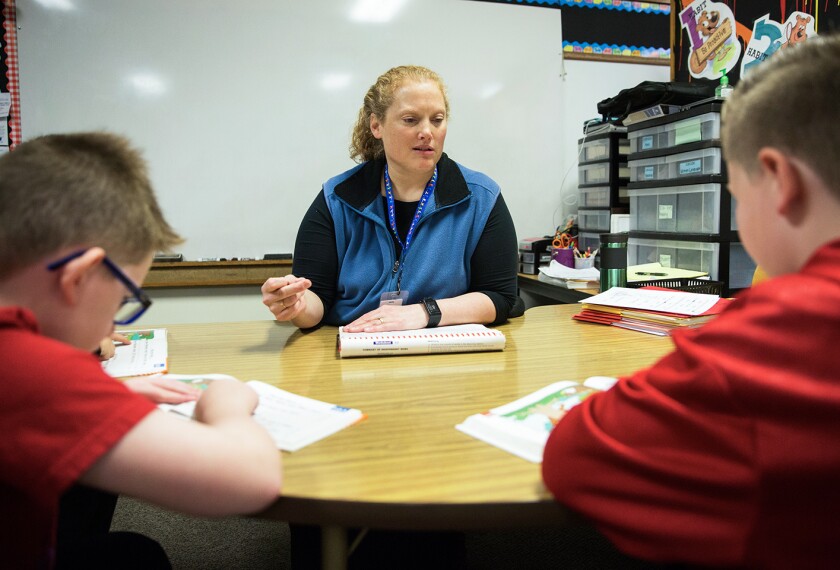Over the past decade, the number of students with disabilities has been increasing, and there’s also a special education teacher shortage.
That has made individualized education programs, which special education students rely on, all the more important, according to experts. All special education students rely on these programs, called IEPs, which allow them to receive educational services tailored to their needs.
In the 2021-22 school year, 14.7 percent of all students nationwide were special education students, reaching an all-time high in 46 years, according to National Center for Education Statistics data.
Even with special education staffing shortages increasing along with special education student numbers, districts are still required to meet the individual needs of these students, according to the U.S. Department of Education.
The Individuals with Disabilities Education Act, or IDEA, is the federal law that mandates special education teachers be appropriately trained and have the knowledge and skills to serve children with disabilities, and that all special education students receive a “free appropriate public education.”
Some states and districts may be skirting the law, the U.S. Department of Education said last year in a letter to state directors of special education. Valerie Williams, the director of the office of special education programs at the education department, warned state directors of special education in a letter that they are still required to meet those requirements.
“In light of a teacher shortage when we are seeing an increase in students with very specific needs, how individualized can we be?” said Brandi Smith, adjunct instructor in the school of education at American University, and a special education teacher.
The document outlines the special educational needs based on the student’s identified disability. It outlines educational goals, and any specialist services they may need to meet those goals, according to Mitchell Yell, a professor of special education at the University of South Carolina.
It is not meant to be a daily instructional plan, but a big-picture summary of the student’s special needs, said James Shriner, Director Emeritus of the IEP Quality Project at the University of Illinois, Urbana-Champaign.
An IEP generally describes a student’s educational programming for a year. If they do not meet the goals outlined in the IEP, the program is changed accordingly in an annual review of the program, Yell said.
“The IEP is essentially a personal accountability or personal accountability document,” Shriner said.
“That document has to be followed very honestly and with fidelity, so that [students with disabilities] are provided the free, appropriate public education, to which [they’re] entitled under the law.”
If a student is referred for an evaluation, generally, a school assessment team will determine whether the student fits into any of the 13 categories under IDEA that qualify that child for an IEP, according to the law.
Those categories include:
- Autism spectrum disorder
- Deaf-Blindness, or simultaneous hearing and visual impairments
- Deafness, including total or partial deafness
- Developmental delay, which means delays in communication, motor skills, or cognitive abilities
- Emotional disturbances, such as anxiety disorder, schizophrenia, bipolar disorder, obsessive-compulsive disorder, and depression
- Hearing impairments, including partial or temporary hearing loss, which aren’t identified under the “deafness” category
- Intellectual disability, such as Down syndrome
- Orthopedic impairment, such as cerebral palsy
- Other health impairments, which can include conditions such as ADHD
- Specific learning disability, such as any condition impacting a child’s ability to read (Dyslexia), write (dysgraphia), or do math (Dyscalculia)
- Speech or language impairment, such as stuttering or difficulty with articulation
- Traumatic brain injury caused by an accident
- Visual impairment, including partial and total blindness
But the overall purpose of the program should be to integrate the special education student into general education, so they can eventually follow the same curriculum as their general education counterparts, Smith said.
“The heart of it is supposed to be access to the curriculum so that the students are able to make the same progress as their peers,” she said.
“It should be written in such a way where they are able to eventually exit into just general ed and any teacher be able to work with them without additional support.”
The student’s potential should be the focus of an IEP instead of their deficits, Smith said.
“A good IEP is anything that centers the way in which the environment can be adjusted and adapted to meet the student’s needs,” she said.
IEPs also need to be reevaluated and adjusted according to the student’s progress, all three experts said.
Students do not need to be on IEPs throughout their schooling if their plans are developed to help them meet educational goals and integrate into general education classrooms, Smith said.
Students whose disabilities do not adversely impact their school performance to a degree where they need specially designed instruction are covered under 504 plans as opposed to IEPs, Shriner said. Schools develop 504 plans to support any students with disabilities, but unlike IEPs, these plans do not have to include specially designed instruction.
“If a kid can … function in school and make progress without specially designed instruction, then they may need a section 504 plan for medical conditions,” Shriner said.
Accommodations under 504 plans can include extra time or separate rooms for students with anxiety to take tests, time to go to the nurse’s office for medications for students with medical conditions, and more.
Once an IEP is written, all teachers involved in the student’s education need to be aware of the special accommodations a student needs, including general education teachers who have students with special needs in their classrooms, according to Yell.
“It is often challenging for schools to communicate the requirements of the IEP to all teachers and to ensure they are implementing these requirements,” he said. “In a school, it is ultimately the principal’s responsibility to ensure implementation.”
The staffing shortage makes it even more challenging for schools to ensure they’re implementing students’ IEPs, since sometimes substitute teachers are not made aware of each student’s individualized needs, Yell said.
This can also make identifying students who need IEPs challenging, Smith said.







